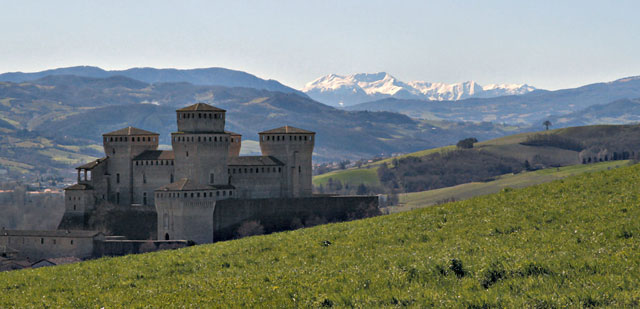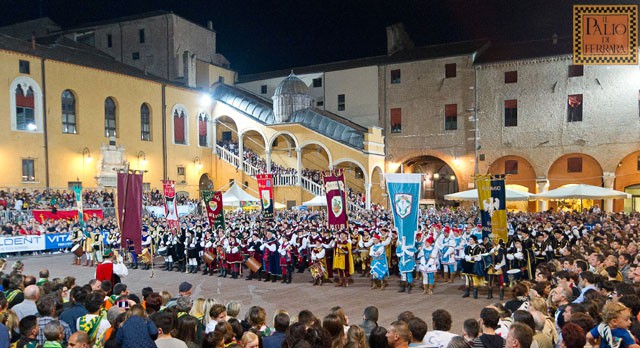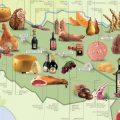
Did you know that the Italian region of Emilia-Romagna comprises two historical areas respectively called Emilia and Romagna? In today’s post, we will explore the western and northeastern portion, Emilia, which comprises the provinces of Piacenza, Parma, Reggio Emilia, Modena, Ferrara and part of Bologna. In particular, we will focus on three aspects that make the area ideal for weddings, family & friend reunions, and foodie trips: castles, folklore and gastronomy.
Parma and Piacenza feature a number of mesmerizing castles, fortresses and palaces, which you can explore through thematic tours, such as history, art, gastronomy and romantic trails. In addition, you can spice up the way you reach and admire these strongholds, for example by traveling in vintage Italian cars or by flying in hot-air balloons.

No matter what your favorite themes and transport means are, you will enjoy a wonderful journey through time: from the Middle Ages to the Renaissance, through Baroque and Enlightenment periods, Romanticism and the Belle Époque, up to the Twentieth Century. You will learn about the history and the deeds of important Italian families, and the impact they had both at local and national level, such as the Borbone, Pallavicino, Sforza, Malaspina and Visconti families.
Are you a foodie? Then you cannot miss the “Dinners in the Castles” experience with Michelin-starred Chefs from Emilia Romagna: an exhibition and tasting of Parmigiano-Reggiano, Grana Padano, Prosciutto di Parma, Culatello di Zibello, Coppa, Pancetta and Salame from Piacenza, the special salt from Salsomaggiore Terme, D.O.C. red and white wines from Parma and Piacenza’s hills.

Emilia’s rich gastronomic offer and quality products make the area an important protagonist of the Expo Milano 2015 event. Arguably, the Prosciutto di Parma and the Parmigiano-Reggiano will be the main made-in-Italy protagonists of the most important fair of the year, which revolves around the theme of “Feeding the Planet, Energy for Life” (for more on the topic, please read Expo Milano 2015, a journey of tastes and seasonality across Italy).
Our next gastronomic pit stop is in Ferrara, northeast of Emilia Romagna’s capital Bologna. For its beauty and cultural importance, this lovely town is a UNESCO World Heritage Site. The local cooking tradition is characterized by many typical dishes that can be traced back to the Middle Ages.
The signature first course is cappellacci di zucca, which are a kind of ravioli with pumpkin filling, Parmigiano-Reggiano and flavored with nutmeg, that are served with a sauce of butter and sage. Among the main courses, the salama da sugo is the queen of Sunday tables: it is an unusual mixture of pork meat seasoned with wine and spices. Seafood is an important part of the town tradition, and grilled or stewed eel from the Po River delta is especially appreciated. Pampepato is the name of the most popular Ferrarese cake, created centuries ago by the nuns of the convent of Corpus Domini: it is a spiced chocolate bread enriched with almonds and candied fruit, topped with a thick layer of melted chocolate!

Ferrara provides also the best example of Emilia’s local folklore, thanks to the world’s oldest palio (horse race) that takes place here. The Palio di Ferrara, also known as Palio di San Giorgio, first took place in 1259 to celebrate the victory of the local marquis Azzo VII “Novello d’Este”. Twenty years later, the palio was instituted as an official event of the town, to be celebrated on 23rd April in honor of St. George (Ferrara’s patron) and on 15th August to celebrate the Virgin Mary.
Nowadays, the Palio di Ferrara is held on the last Sunday of every May, to commemorate an extraordinary race that took place in 1471 when marquis Borso d’Este was named First Duke of Ferrara by Pope Paul II. A costume parade and a show by flag throwers kicks off the celebrations, with all participants dressed up according to the fashion style of the late 1400s.
The exhilarating races (also in medieval costume) are run in the historical Piazza Ariostea, a square surrounded by numerous buildings that have a great architectural value. The whole event is simply breathtaking, and takes you back to the Renaissance, a period during which Ferrara stood as one of the major cultural capitals in Europe.
Are you planning a special occasion in Italy? Make it extra special and unforgettable by providing your guests or clients with authentic experiences that reveal the hidden traditions and precious spirit of local Italian communities. Contact Italian Special Occasions DMC for ideas and for a customized quotation
Photo credits:
Castello di Torrechiara – image by Davide Bolsi
The castles of Piacenza and Parma can be admired from hot-air balloons too! Image from castellidelducato.it
Parmigiano-Reggiano factory! Image from parmigianoreggiano.it
The Piazza heats up and gets ready for the Palio in Ferrara. Image from paliodiferrara.it



